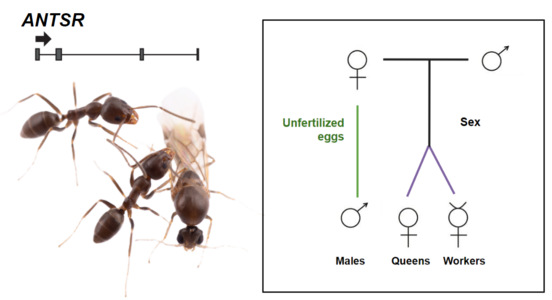Pan/Darras/Keller Valsecchi/Ketting
Seeking ANTSR: Investigating the molecular mechanisms and evolution of sex determination in Hymenoptera
Supervisor: Qiaowei (Miya) Pan
Co-Supervisor: Hugo Darras, Claudia Keller Valsecchi, René Ketting
Scientific Background
Sex determination mechanisms are remarkably variable across animal species, yet research remains scarce on primary sex determination genes beyond model organisms. Haplodiploidy is a sex determination system in which females are diploid, and males are haploid. This system has evolved repeatedly and occurs in approximately 12% of animal species, including all Hymenoptera (ants, bees, wasps, and sawflies), many of which possess significant ecological and economic value. Despite the prevalence of haplodiploidy, its molecular mechanisms have been only described in three taxa, each employing distinctly different operational machinery: honey bees, Nasonia parasitic wasps, and the Argentine ant. In honey bees,a multiallelic gene governs sex determination through differential protein binding affinity (Otte et al. 2023).In contrast, in Nasonia parasitic wasps, sex is determined via maternal imprinting (Zou et al. 2020). Our recent work reveals that a hyper-polymorphic region determines sex through allele complementarity in the Argentine ant: heterozygous embryos develop into females, while homozygous and hemizygous embryos develop into males (Pan et al. 2024). Heterozygosity at this locus correlates with higher expression of ANTSR, a gene that specifies a long non-coding RNA (lncRNA) transcript and triggers female development. Interestingly, in contrast to the master sex-determining genes of honey bees and Nasonia that are evolutionarily nascent, the hyper-polymorphic region containing ANTSR is ancestral to all modern ants and likely emerged before ants, bees, and stinging wasps diverged from other Hymenoptera. The regulatory mechanism responsible for the high expression of ANTSR in heterozygotes and the mode of action of this lncRNA are yet unknown.
Project description
The goal of this PhD project is to explore the molecular regulation and evolutionary dynamic of ANSTR, an lncRNA mediating genetic sex determination in Argentine ants. The recent discovery of ANSTR adds to a growing body of evidence that lncRNAs contribute to various essential developmental processes (Valsecchi et al. 2021, Wittkopp et al. 2024), but its evolutionary history and mode of action are yet unclear.
In this project, you will employ comparative genomics approaches to capture the functions and evolutionary dynamics of ANTSR and the hyper-polymorphic region it is associated with among Hymenoptera. In parallel, you will use functional genomics, molecular, and proteomics techniques to investigate the mechanisms of this newly discovered master sex regulator (Bopp, Saccone, and Beye 2014; Wexler et al. 2019). This project will provide the first insights into how sex determination evolves over evolutionary time scales in haplodiploid systems.
What you will learn
During this project, you will become proficient in techniques related to epigenomics (RNA-seq, CUT&Run, and CUT&Tag), tissue culture, insect rearing, genome engineering, microscopy, and evolutionary genomics. You will learn how to independently develop ideas, pursue a research project and communicate your results in oral and written form. This includes developing skills such as critical thinking, working and collaborating in an international environment, project management, scientific writing and public speaking during international conferences. Besides the training program and courses of the Genevo RTG, we will support you in your career planning.
Your qualifications
We are seeking a student with a keen interest in epigenetics, developmental biology, and evolutionary biology. The ideal candidate is eager to combine wet lab work, imaging/microscopy, and bioinformatic approaches (pre-existing training in these areas is not necessary). Previous experience with ants or other insects is a plus. We are looking for someone who is enthusiastic about advancing this project in an international and multidisciplinary environment. If you are a team player with a high degree of motivation and passion for science, we encourage you to apply to join our team.
Publications relevant to this project
Otte M, Netschitailo O, Weidtkamp-Peters S, Seidel CAMl, Beye M (2023) Recognition of Polymorphic Csd Proteins Determines Sex in the Honeybee. Science Advances 9 (40): eadg4239. https://doi.org/10.1126/sciadv.adg4239
Pan Q, Darras H, Keller L (2024) LncRNA Gene ANTSR Coordinates Complementary Sex Determination in the Argentine Ant. Science Advances 10(22): adp1532. https://doi.org/10.1126/sciadv.adp1532
Keller Valsecchi CI, Basilicata MF, et al. (2021) RNA Nucleation by MSL2 Induces Selective X Chromosome Compartmentalization. Nature 589 (7840): 137–42. https://www.nature.com/articles/s41586-020-2935-z
Wittkopp N, Jesus Domingues AM, Ketting RF (2024) miR214 Regulates Sex Determination through Gsdf in Zebrafish. bioRxiv. https://doi.org/10.1101/2024.05.01.592007
Zou Y, Geuverink E, Beukeboom LW, Verhulst EC, van de Zande L (2020) A Chimeric Gene Paternally Instructs Female Sex Determination in the Haplodiploid Wasp Nasonia. Science 370 (6520): 1115–18. https://doi.org/10.1126/science.abb8949
